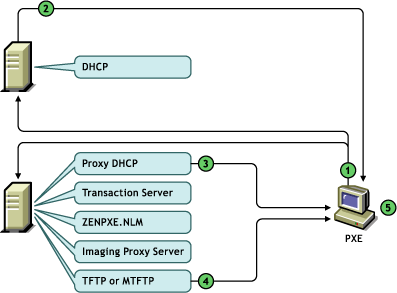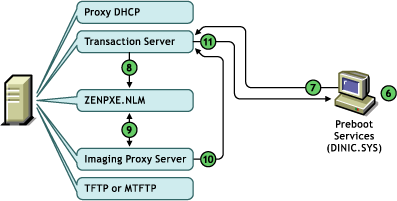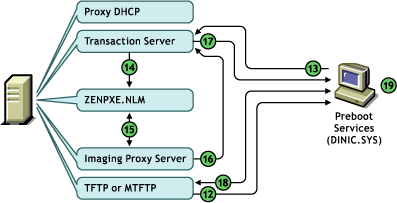Understanding Desktop Management Preboot Services
This section contains information that will help you to understand Desktop Management Preboot Services, including:
- About Desktop Management Preboot Services
- Typical Preboot Services Operation
- Preboot Services Process Diagrams
About Desktop Management Preboot Services
PXE (Preboot Execution Environment) is an industry-standard protocol that allows a workstation to boot up and execute a program from the network before the workstation operating system starts. PXE uses DHCP (Dynamic Host Configuration Protocol) and TFTP (Trivial File Transfer Protocol). The PXE environment is loaded from either the NIC in flash memory or read-only memory, or in the same memory as the system BIOS.
Desktop Management Preboot Services uses PXE to find out if there is imaging work specified for a workstation and to provide the workstation with the files necessary to boot to the Desktop Management imaging environment.
By using Preboot Services, you can put an image on a workstation even if the workstation's hard disk is blank. You do not need to use Desktop Management imaging boot diskettes (SP1 only), a ZENworks Desktop Management imaging boot CD or DVD, or a Desktop Management imaging hard-disk (Linux) partition on the workstation.
Before you can use Preboot Services, you need to do the following:
- Install the Desktop Management Imaging and Preboot Services (PXE Support) components on your imaging server.
- Enable PXE on the workstation.
- Have a standard DHCP server, either on your Imaging server or on another network server.
For information about requirements, installing Desktop Management and Preboot Services on your Imaging server, enabling PXE on a workstation, and configuring your DHCP server, see Installing and Setting Up Desktop Management Preboot Services.
Typical Preboot Services Operation
When a PXE-enabled workstation starts to boot up, it sends a DHCP discovery request to determine the IP address of the Preboot Services/Imaging server. The DHCP server responds with an IP address for the client to use, and the Proxy DHCP server responds with the IP addresses of the Transaction server, TFTP, and MTFTP (Multicast TFTP) servers, as well as the filename of the Preboot Services client.
The PXE workstation then downloads the Preboot Services client (dinic.sys) using either TFTP or MTFTP.
After the Preboot Services client is downloaded and executed, the workstation checks the Preboot Services Transaction server to see if there is any imaging work to do. If there is imaging work to do, it downloads the Desktop Management Workstation Imaging environment (linux.1, linux.2, and loadlin.exe in ZENworks 6.5 Desktop Management SP1 and earlier; initrd, linux, and root in ZENworks 6.5 Desktop Management SP2 and later) from the server so that the workstation can be booted to Linux and any imaging tasks can be performed. If there are no imaging tasks to perform, these files are not downloaded and the workstation proceeds to boot to its operating system.
Preboot Services Process Diagrams
The following diagrams show the interaction between a Preboot Services (PXE) client workstation and a Preboot Services/Imaging server, starting when the PXE client workstation is turned on and begins to boot up, and ending when imaging work begins on that workstation.
Three diagrams are used to show one complete process. The first diagram shows steps 1-5, the second diagram shows steps 6-11, and the third diagram shows steps 12-19. Each number corresponds to explanatory text in a table following the diagram.
In this example, the DHCP server and the Preboot Services/Imaging server are two separate servers on the network, although it is possible to run both from the same server with some additional configuration. This example also assumes that the client workstation and the servers are in the same segment.
Diagram 1 (Steps 1-5)

| Step | Explanation |
|---|---|
|
The workstation is turned on and begins to boot up. PXE (triggered by the BIOS, network interface card, or PXE-on-Disk boot diskette) sends a DHCP request to the network. The DHCP request includes PXE extensions. |
|
The DHCP server responds with an IP address for the workstation to use. This step may occur before or after Step 3. |
|
The Proxy DHCP server responds with the IP addresses of the Preboot Services Transaction server, Preboot Services TFTP and MTFTP servers, and with the name of the Preboot Services client (dinic.sys). The Preboot Services client includes a preboot component that makes the workstation available on the network before the operating system has loaded. This component ensures that the workstation can contact the Transaction server (in Step 7) even when there is no operating system installed on the workstation. |
|
Using TFTP or MTFTP, the Preboot Services client (dinic.sys) is downloaded to the PXE client workstation. By default, TFTP is used because it speeds the workstation's boot process; however, you can change the configuration to use MTFTP. For more information, see Installing and Setting Up Desktop Management Preboot Services. If a PXE-on-Disk boot diskette was used in Step 1, the Preboot Services client does not need to be downloaded, and this step does not occur. |
|
The Preboot Services client is loaded on the PXE client workstation. |
Diagram 2 (Steps 6-11)

Diagram 3 (Steps 12-19)



















